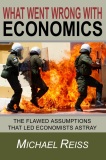Thursday, 19 December 2013
Why our monetary system contributes to the gap between rich and poor
* We have a monetary system in which loans create money and repayments destroy money. So at any one time the amount of money in the economy is approximately equal to the amount of outstanding loans.
* Most (90% ish) of the outstanding loans in the economy have been for the purposes of buying assets (mostly housing, but also stocks and shares).
* Rich people are keen to borrow to buy assets when they have confidence that the price of those assets are going to rise.
* If the rich lose confidence that asset prices are going to rise they will be less keen to borrow money. This will shrink the money supply and lead to recession, like in the 1930's where the money supply fell by about a third.
* The only way the government know how to prevent a collapse in the money supply is to do everything in their power to give rich people the confidence that asset prices will rise. This means that the government are actively doing everything they can to ensure that the rich asset owning classes become richer at the expense of poorer people. Things like "help to buy", whose primary effect is to increase house prices.
* Making the rich richer is the only thing governments can think of to prevent a financial collapse! How long are we going to continue with this madness?
* Switching to full reserve banking means that the money supply can be held stable without handing the rich more money from the poor.
Subscribe to:
Post Comments (Atom)




No comments:
Post a Comment